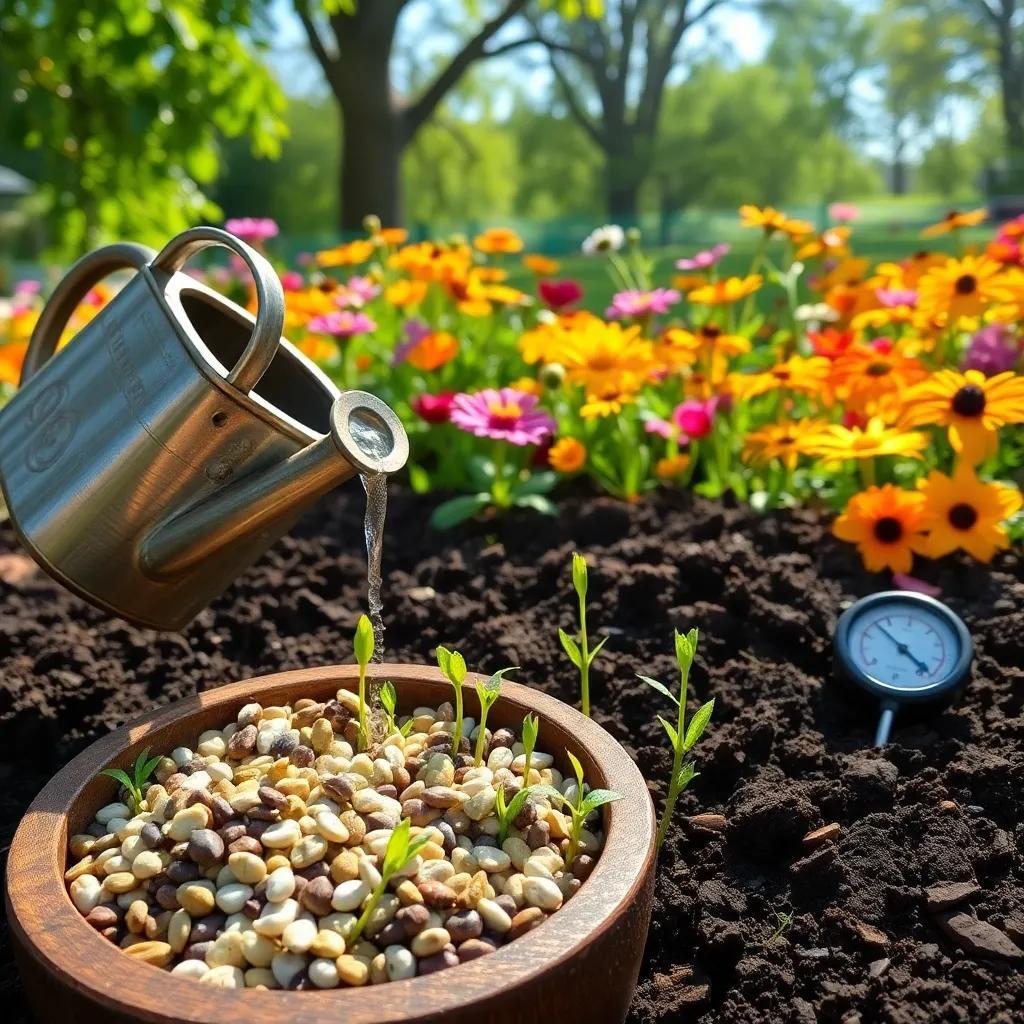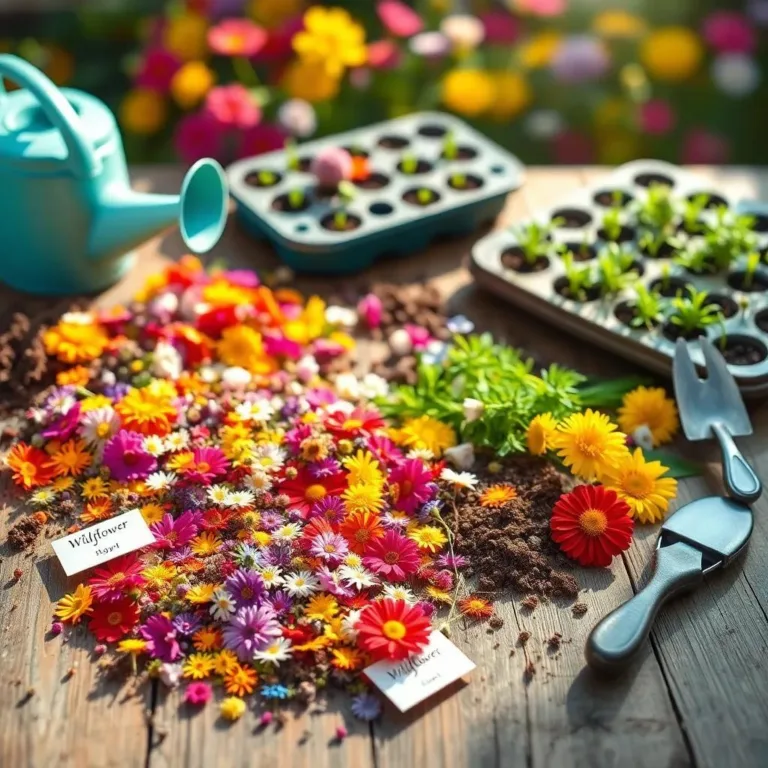Are you ready to transform your garden into a colorful wildflower paradise? I’m here to share everything you need to know about growing these beautiful blooms from seed! From understanding germination to tackling tricky challenges, let’s dig in and discover the joyful world of wildflowers together! 🌼
Factors Influencing Wildflower Germination Rates
When it comes to germinating wildflowers, several factors can either help or hinder the process. It’s a bit like baking a cake; you need the right ingredients and conditions to get that perfect rise! Here are the main players that can affect how well your seeds germinate:
- Temperature: Most wildflower seeds have a preferred temperature range for sprouting. For many, that’s between 60°F and 75°F (15°C to 24°C). If it’s too cold or too hot, the seeds might just sit there, twiddling their thumbs, as if they’re waiting for a bus that isn’t coming!
- Moisture: Seeds love water but not too much! They need consistent moisture to kick-start the germination process. Think of it like watering a plant; you want it damp, not swimming! Too much water can lead to rot, while too little can make your seeds feel parched.
- Light: This one’s interesting! Some seeds need light to germinate, while others thrive in the dark. You wouldn’t believe how picky they can be! Just make sure to check what your specific wildflower needs.
- Soil Quality: Good soil is like a cozy bed for your seeds. It should be well-drained and rich in nutrients. A mix of compost, sand, and garden soil is a great start. You don’t want your seeds to feel like they’re in quicksand!
- Seed Dormancy: Some seeds have a built-in dormancy mechanism, which means they don’t sprout right away. They might need a little help, like scarification or stratification, to wake them up!
By paying attention to these factors, we can create a welcoming environment for our wildflower seeds, making sure they’re ready for their big debut in our gardens!
Average Germination Times for Popular Wildflower Species
So, you’re excited about your wildflower garden, huh? Let’s talk about how long you might be waiting for those beautiful blooms to pop up! Different wildflowers have different germination times. Think of it like waiting for your favorite food to cook. Some dishes take longer than others, right? Here’s a handy little table to give you a quick glance at some popular wildflower species and their germination times:
| Wildflower Species | Germination Time |
|—————————|———————|
| California Poppy | 7 to 14 days |
| Cosmos | 7 to 10 days |
| Black-eyed Susan | 10 to 20 days |
| Indian Blanket | 10 to 14 days |
| Purple Coneflower | 10 to 20 days |
| Sunflower | 7 to 10 days |
| Blanket Flower | 14 to 21 days |
| Coreopsis | 10 to 14 days |
| Lupine | 14 to 21 days |
| Marigold | 5 to 7 days |
Keep in mind, these times are just averages. It’s like waiting for your friends to show up; sometimes they’re early, sometimes late! Factors like soil quality, moisture, and temperature can cause variations. It’s always good practice to be patient and keep an eye on your garden.
So, whether you’re a seasoned gardener or just starting, remember that each wildflower has its own rhythm. Enjoy the process, and soon enough, you’ll have a gorgeous garden full of colorful blooms! Happy planting! 🌼

Essential Seed Preparation Techniques for Wildflowers
Getting your wildflower seeds ready for planting is like preparing your favorite dish – it can make all the difference! Proper seed preparation boosts germination rates and sets the stage for strong, healthy plants. Here are some fun and effective techniques I like to use:
- Scarification: This is a fancy word for scratching the seed coat! Some wildflower seeds have a tough exterior that makes it hard for water to seep in. By gently nicking them with a file or sandpaper, you let moisture in, which helps kickstart the germination process. Just be careful not to hurt the seed inside!
- Stratification: Life can be rough for seeds that need to experience cold weather before they sprout. This technique mimics winter chill. Place your seeds in a damp paper towel, put them in a plastic bag, and toss them in the fridge for a couple of weeks. They’ll think they’ve hibernated and will spring to life when planted!
- Soaking: Some seeds love a good soak! Placing them in water for a few hours can help soften their seed coat. This is a quick way to help water absorption and get things moving along.
- Pre-chilling: Similar to stratification, this involves keeping seeds in cooler temperatures, but typically for a shorter duration. This technique is helpful for those seeds that just need a little nudge.
- Hot Water Treatment: For seeds with especially hard coats, a brief soak in hot water can do wonders. Just remember not to let them sit too long – we want them cozy, not cooked!
By using these techniques, I’ve seen my wildflower gardens flourish like never before. Every seed has a unique personality, so it’s important to research what works best for the type of wildflower you’re planting!
Optimal Conditions for Successful Wildflower Germination
After you’ve prepped your seeds, it’s time to create a cozy environment that helps them germinate. Think of it as creating a little spa retreat for your wildflowers! Here’s what you’ll need:
- Temperature: Most wildflower seeds like it cozy, living in a temperature range of 60°F to 75°F (15°C to 24°C). If it’s too hot or too cold, they might just stay in bed!
- Moisture Levels: Water is key, but not too much! You want the soil to feel like a damp sponge. Water the soil before planting your seeds and keep it consistently moist during germination. It’s all about balance – we want happy seeds, not soggy ones!
- Soil Quality: Choose nutrient-rich, well-drained soil. A mix of compost and garden soil works wonders. This helps prevent waterlogging, which can drown your seeds and seedlings.
- Light Requirements: Some seeds like a little sunshine during germination, while others prefer the shade. Check what your seeds need. If they like light, don’t bury them too deep!
- Air Circulation: Good airflow is important to keep mold at bay. I like to space my seeds out and avoid overcrowding, making sure they have room to breathe.
By providing the right environment, I’ve watched my wildflowers sprout joyfully, bringing color and life to my garden. It’s all about creating that perfect space for them!
Troubleshooting Common Wildflower Germination Issues
Sometimes, despite our best efforts, things don’t go as planned. But don’t worry! I’ve faced germination issues too, and there are ways to troubleshoot them.
- Poor Germination Rates: If your seeds aren’t sprouting as expected, double-check the conditions. Are the temperature and moisture levels right? Ensure you’re using fresh, viable seeds from a trustworthy source!
- Mold or Fungal Growth: If you see mold, it’s likely due to too much moisture or poor air circulation. Try reducing water and improving airflow. A small fan can go a long way!
- Damping Off: This is a sneaky fungal disease that can make seedlings collapse. Keep soil moist but not soggy, and avoid overcrowding your seedlings. If you notice any wilting, remove affected plants immediately!
- Insect Damage: Pests love young plants! Regularly check for signs of insect damage. If you spot them, consider using natural repellents or organic pest control methods to help protect your garden.
- Uneven Germination: If some seeds sprout faster than others, give the slower ones more time. Just like people, seeds have their own pace! You can also try stratifying those that are lagging.
When faced with challenges, remember that gardening is all about patience and learning. With a little troubleshooting and care, I’ve turned problems into successes, resulting in a thriving wildflower garden! Happy gardening!

